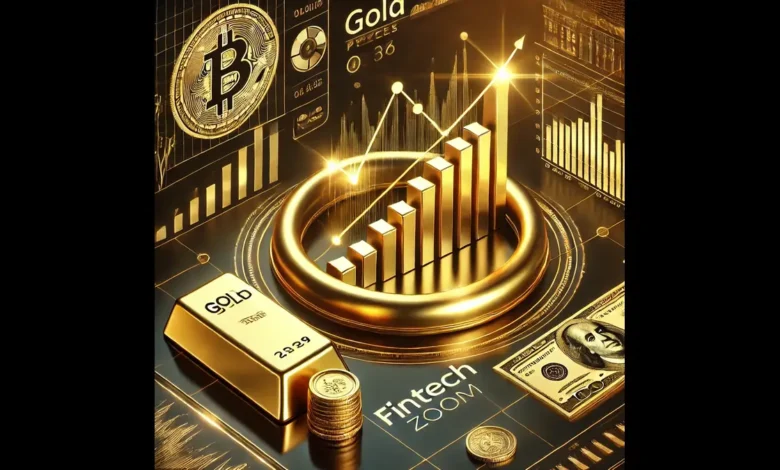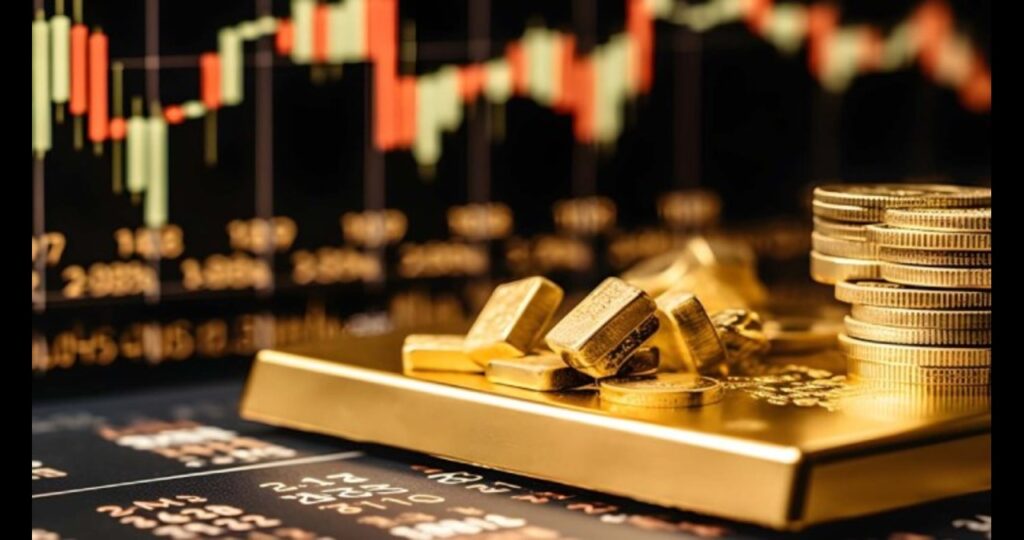Exploring the Relationship Between Economic Factors and Gold Price FintechZoom

Introduction to Gold Price FintechZoom
Gold Price FintechZoom has always held a special place in the hearts and wallets of investors. As a timeless asset, it glimmers not just with beauty but also with potential for profit. Yet, its price is rarely static; rather, it’s influenced by an intricate web of economic factors that can shift rapidly. Understanding these dynamics is crucial for anyone looking to navigate the complex world of gold investment.
As we delve into the relationship between economic indicators and gold prices, we’ll uncover how inflation rates, interest fluctuations, stock market trends, and global conditions shape this precious metal’s value. With advancements in technology reshaping trading methods through fintech innovations like digital gold investments, there’s never been a more exciting time to explore these connections. Join us as we dissect what drives gold prices and discover insights that could guide your future investment decisions on platforms like FintechZoom!
Factors that Influence Gold Prices
Gold Price FintechZoom are influenced by a myriad of factors that reflect the global economy’s pulse. Inflation stands as a significant determinant; when inflation rises, gold often becomes a preferred hedge. Investors flock to this precious metal, driving its price upward.
Interest rates also play a crucial role. Lower interest rates diminish the opportunity cost of holding gold, making it more attractive compared to interest-bearing assets. Consequently, demand surges and so does the price.
The stock market performance cannot be overlooked either. When equities falter, investors frequently seek refuge in gold as a safe haven asset.
Global economic conditions shape investor sentiment towards gold. Geopolitical tensions or crises can lead to spikes in demand as individuals look for stability amidst uncertainty. These interconnected dynamics create an ever-evolving landscape for gold pricing.

– Inflation
Inflation is a significant driver of gold prices. When the cost of goods and services rises, currencies tend to lose their purchasing power. Investors often flock to gold as a hedge against this erosion.
Gold has historically maintained its value during inflationary periods. Its allure lies in being a tangible asset that doesn’t depend on government policies or fiat currency stability.
As inflation expectations rise, demand for gold increases. This surge can lead to higher prices, attracting more investors seeking security amidst economic uncertainty.
Central banks also play a role here. Their decisions regarding money supply directly impact inflation rates and subsequently influence the appeal of gold as an investment.
Many view gold not just as jewelry or decoration but as financial insurance during turbulent times when inflation looms large on the horizon.
– Interest Rates
Interest rates play a pivotal role in determining gold prices. When central banks raise interest rates, the opportunity cost of holding non-yielding assets like gold increases. Investors often shift their focus to interest-bearing investments, which can lead to a decline in demand for gold.
Conversely, when interest rates are low or cut, gold becomes more appealing. It doesn’t generate income but serves as a hedge against currency devaluation and inflation. This environment typically drives investors back to the safe haven of gold, pushing up its price.
The interrelationship between these factors is complex. Speculation around future rate changes can create volatility in the market too. Traders often watch economic indicators closely, as they signal potential shifts in monetary policy that could impact how attractive gold remains compared to other investments.
– Stock Market Performance
Stock market performance plays a significant role in influencing gold prices. When equity markets are thriving, investors often flock to stocks rather than safe-haven assets like gold. This shift can lead to diminished demand for gold, causing its price to drop.
Conversely, during stock market downturns or heightened volatility, many turn to gold as a protective measure against financial uncertainty. Investors view it as a stable asset that retains value when the stock market fluctuates wildly.
Traders and analysts frequently monitor stock indices closely alongside precious metals. A downward trend in equities might signal an uptick in gold investments as individuals seek refuge from potential losses.
Understanding this correlation helps investors strategize effectively. Those engaged in both markets can identify optimal entry points for their trades based on prevailing economic sentiment reflected in stock performance and corresponding movements in the gold price fintechzoom sector.
– Global Economic Conditions
Global economic conditions play a pivotal role in determining gold prices. When uncertainty looms—be it due to geopolitical tensions, trade disputes, or pandemics—investors often flock to gold as a safe haven.
Economic downturns can amplify this trend. As consumer confidence dips, people seek stability in tangible assets like gold. This surge in demand typically drives up the price.
Conversely, when economies are on solid footing and growth is robust, interest may wane. Investors might gravitate towards higher-risk assets for greater returns. In such scenarios, gold could see decreased market activity.
Exchange rates also influence global trading conditions. A weakening dollar often leads to higher gold prices internationally since it becomes cheaper for holders of other currencies to purchase the metal.
Market watchers should keep an eye on these shifting tides as they navigate investments within the context of ever-changing global dynamics.
The Role of Fintech in the Gold Market
Fintech has transformed the gold market, bridging traditional investments with modern technology. Digital platforms now allow investors to buy and sell gold seamlessly, without the need for intermediaries.
These innovations have made it easier for everyday consumers to enter the gold market. With just a smartphone app, anyone can invest in gold bars or coins from anywhere in the world.
Moreover, blockchain technology enhances transparency and security in transactions. This ensures that each purchase is verifiable and traceable, reducing fraud risks significantly.
Fintech also introduces fractional ownership of gold assets. Investors no longer need substantial capital; they can own a portion of valuable assets at lower costs.
As fintech continues to evolve, it’s reshaping how we perceive value in precious metals. The integration of technology streamlines processes while making investment more accessible than ever before.
– Digital Gold Investments
Digital Gold Price FintechZoom investments are transforming how individuals access this precious asset. With the rise of fintech platforms, buying and trading gold has become more accessible than ever.
Investors can now purchase fractional amounts of gold through digital wallets. This ease of entry allows newcomers to diversify their portfolios without significant upfront costs.
Moreover, online marketplaces facilitate real-time transactions. Investors can buy or sell gold at market prices with just a few clicks, removing traditional barriers associated with physical purchases.
Security is another advantage. Blockchain technology ensures transparency and authenticity in ownership records, reducing the risk of fraud.
Additionally, these platforms often provide educational resources. They empower investors to make informed decisions about their holdings based on economic trends affecting the Gold Price FintechZoom landscape.
The convenience and efficiency offered by digital investments redefine how we think about wealth accumulation in today’s economy.
– Impact on Traditional Gold Trading Methods
The rise of fintech has significantly transformed traditional gold trading methods. Investors are now leveraging technology to buy and sell gold in a more streamlined way. Gone are the days when physical visits to dealers were necessary.
Digital platforms enable seamless transactions, allowing users to trade from anywhere. This accessibility attracts younger investors who prefer online solutions over conventional means.
In addition, these platforms often provide real-time data analytics. Investors can track price fluctuations instantly, making informed decisions on their trades.
Moreover, fintech innovations have introduced fractional ownership of gold assets. This allows individuals to invest smaller amounts without needing substantial capital upfront.
With lower barriers to entry, more people can participate in the gold market than ever before. The interplay between tech and tradition is reshaping how we view and engage with this precious commodity.
Case Studies: How Economic Factors Affect Gold Prices
Case studies reveal fascinating insights into how economic factors sway gold prices. For instance, during the 2008 financial crisis, investors flocked to gold as a safe haven. This surge in demand drove prices up dramatically.
Another example is the inflation spike seen in various countries. When inflation rates rise, purchasing power declines, prompting many to invest in gold. This often results in significant price increases as buyers compete for limited supplies.
Conversely, periods of low interest rates tend to correlate with higher gold prices. With lower returns on other investments like bonds or savings accounts, more individuals turn their attention toward bullion.
Global tensions also play a crucial role. Events such as trade wars or geopolitical conflicts can trigger fear among investors and push them towards securing their wealth through gold purchases.
These case studies illustrate how interconnected economic conditions are with fluctuations in the value of gold.
Future Predictions for the Relationship Between Economic Factors and Gold Prices
As we look ahead, the interplay between economic factors and Gold Price FintechZoom is poised for significant shifts. Rising global uncertainty may drive investors back to safe-haven assets like gold.
Inflation rates are expected to fluctuate, impacting purchasing power and investment strategies. Higher inflation typically elevates gold’s appeal as a hedge against currency depreciation.
Interest rates will also play a crucial role. Central banks’ decisions in this area will influence borrowing costs and consumer spending habits, ultimately affecting demand for gold.
Moreover, geopolitical tensions could create volatility in traditional markets, further boosting interest in gold investments. As digital platforms evolve, they might reshape how investors access and trade this precious metal.
Understanding these trends can empower informed decisions within the ever-evolving landscape of Gold Price FintechZoom.
Conclusion: The Importance of Keeping Up with Economic Trends
Understanding the intricate relationship between economic factors and gold prices is essential for investors and financial enthusiasts alike. As we navigate a dynamic marketplace, being aware of how inflation, interest rates, stock market fluctuations, and global economic conditions influence gold pricing can help in making informed decisions.
The rise of fintech has further transformed this landscape. Digital investments in gold offer new avenues for both seasoned traders and newcomers to engage with precious metals seamlessly. The impact on traditional trading methods cannot be overstated—it brings efficiency but also poses unique challenges.
With case studies illustrating these connections, it’s clear that external circumstances significantly sway gold prices. Awareness of these trends will not only empower individuals to strategize better but also enhance their understanding of broader market movements.
Keeping up with economic trends isn’t just advisable; it’s crucial for anyone looking to maintain an edge in investment strategies related to gold price dynamics on platforms like Gold Price FintechZoom.. Staying informed equips you to respond proactively rather than reactively—an invaluable approach in today’s fast-paced economy.